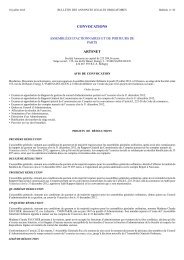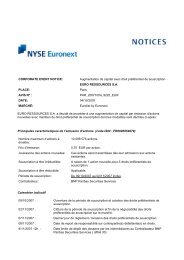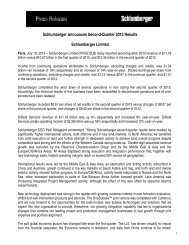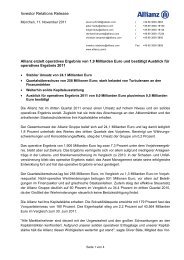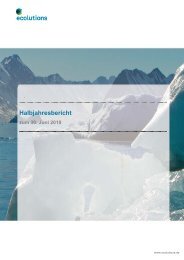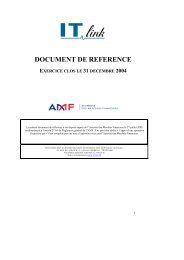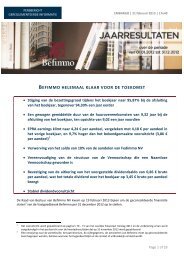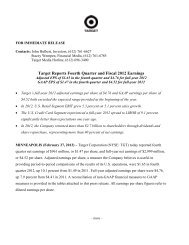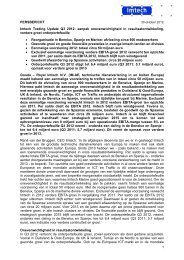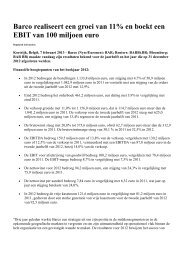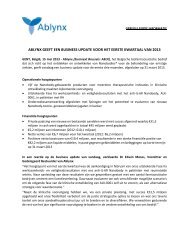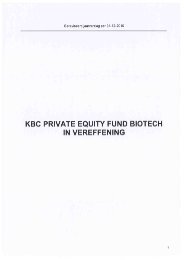FORM 10-Q
FORM 10-Q
FORM 10-Q
You also want an ePaper? Increase the reach of your titles
YUMPU automatically turns print PDFs into web optimized ePapers that Google loves.
ased on quoted market prices. For investments in non-publicly traded companies, management's assessment of fair value is based on valuation<br />
methodologies including discounted cash flows, estimates of sales proceeds and appraisals, as appropriate. We consider the assumptions that we believe<br />
hypothetical marketplace participants would use in evaluating estimated future cash flows when employing the discounted cash flow or estimates of sales<br />
proceeds valuation methodologies. The ability to accurately predict future cash flows, especially in developing and emerging markets, may impact the<br />
determination of fair value.<br />
In the event the fair value of an investment declines below our cost basis, management is required to determine if the decline in fair value is other than<br />
temporary. If management determines the decline is other than temporary, an impairment charge is recorded. Management's assessment as to the nature of a<br />
decline in fair value is based on, among other things, the length of time and the extent to which the market value has been less than our cost basis; the<br />
financial condition and near-term prospects of the issuer; and our intent and ability to retain the investment in the issuer for a period of time sufficient to allow<br />
for any anticipated recovery in market value.<br />
The following table presents the difference between calculated fair values, based on quoted closing prices of publicly traded shares, and our Company's cost<br />
basis in publicly traded bottlers accounted for as equity method investments (in millions):<br />
March 29, 2013<br />
Fair<br />
Value<br />
Carrying<br />
Value Difference<br />
Coca-Cola FEMSA, S.A.B. de C.V. $ 9,220 $ 2,180 $ 7,040<br />
Coca-Cola Amatil Limited 3,355 1,021 2,334<br />
Coca-Cola Hellenic Bottling Company S.A. 2,367 1,402 965<br />
Coca-Cola Icecek A.S. 1,488 221 1,267<br />
Embotelladora Andina S.A. 834 403 431<br />
Coca-Cola Central Japan Co., Ltd. 191 149 42<br />
Coca-Cola Bottling Co. Consolidated 150 79 71<br />
Mikuni Coca-Cola Bottling Co., Ltd. <strong>10</strong>9 90 19<br />
Total $ 17,714 $ 5,545 $ 12,169<br />
As of March 29, 2013, gross unrealized gains and losses on available-for-sale securities were $ 506 million and $16 million, respectively. Management<br />
assessed each investment with unrealized losses to determine if the decline in fair value was other than temporary. Based on these assessments, the Company<br />
did not record any significant impairment charges related to available-for-sale securities during the three months ended March 29, 2013, and March 30, 2012.<br />
We will continue to monitor these investments in future periods. Refer to Note 3 of Notes to Condensed Consolidated Financial Statements.<br />
Goodwill, Trademarks and Other Intangible Assets<br />
Intangible assets are classified into one of three categories: (1) intangible assets with definite lives subject to amortization; (2) intangible assets with indefinite<br />
lives not subject to amortization; and (3) goodwill. For intangible assets with definite lives, tests for impairment must be performed if conditions exist that<br />
indicate the carrying value may not be recoverable. For intangible assets with indefinite lives and goodwill, tests for impairment must be performed at least<br />
annually, or more frequently if events or circumstances indicate that an asset might be impaired.<br />
Management's assessments of the recoverability and impairment tests of intangible assets involve critical accounting estimates. These estimates require<br />
significant management judgment, include inherent uncertainties and are often interdependent; therefore, they do not change in isolation. Factors that<br />
management must estimate include, among others, the economic life of the asset, sales volume, pricing, cost of raw materials, delivery costs, inflation, cost of<br />
capital, marketing spending, foreign currency exchange rates, tax rates, capital spending and proceeds from the sale of assets. These factors are even more<br />
difficult to predict when global financial markets are highly volatile. The estimates we use when assessing the recoverability of definite-lived intangible assets<br />
are consistent with those we use in our internal planning. When performing impairment tests of indefinite-lived intangible assets, we estimate the fair values of<br />
the assets using management's best assumptions, which we believe would be consistent with what a hypothetical marketplace participant would use. Estimates<br />
and assumptions used in these tests are evaluated and updated as appropriate. The variability of these factors depends on a number of conditions, including<br />
uncertainty about future events, and thus our accounting estimates may change from period to period. If other assumptions and estimates had been used when<br />
these tests were performed, impairment charges could have resulted. As mentioned above, these factors do not change in isolation and, therefore, we do not<br />
believe it is practicable or meaningful to present the impact of changing a single factor. Furthermore, if management uses different assumptions or if different<br />
conditions occur in future periods, future impairment charges could result. Refer to the heading "Operations Review" below for additional information related<br />
to our present business environment. Certain factors discussed above are impacted by our current business environment and are discussed throughout this<br />
report, as appropriate.<br />
26



